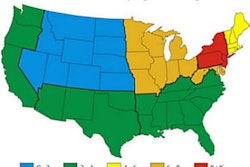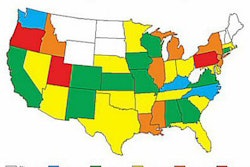As a more comprehensive response to spiraling costs fueled by nonradiologist self-referral, the American College of Radiology is proposing that Congress place limits on who can provide imaging to Medicare patients.
Details of the "designated physician imager" (DPI) proposal -- essentially, a federal privileging program -- are still in the works. The college will soon promote the concept to potential sponsors of legislation within the newly convened 109th Congress, according to ACR chairman Dr. James Borgstede.
"We don't envision that anything will be enacted instantaneously," Borgstede said in an interview with AuntMinnie.com. "This will be a months- to years-long effort."
But beginning the process is imperative, Borgstede said, given economic trends that might otherwise inspire Congress to simply cut reimbursement for imaging services to help balance the federal budget.
Over $3 billion saved?
"Our estimates, conservatively, are that this approach of selective providers of imaging services could save CMS (the Centers for Medicare and Medicaid Services) $3 billion. So even in federal money you're talking real dollars," Borgstede said.
Indeed, the ACR's analysis suggests that the DPI approach could save Medicare from $3 billion to $8 billion per year. Total Medicare expenditures for 2004 are likely to top $260 billion, based on recent trends.
The basis for the ACR's savings estimates is a series of studies showing that self-referring nonradiologists are far more likely to overutilize imaging, and that nonradiologists are the big drivers of recent escalation.
Diagnostic imaging is the fastest-growing physician service, according to testimony from the Medicare Payment Advisory Committee (MedPAC). The recent 9% annual growth in diagnostic imaging services is three times that of other physician services.
The notion that Medicare might single out imaging services for lower reimbursement isn't farfetched, Borgstede said, noting that there was previously a separate conversion factor for surgical CPT codes.
But cuts to imaging reimbursement would hurt radiologists more than self-referring nonradiologists, who could more easily increase their volumes. Also, if imaging became a loss leader for hospitals, the incentives for investment in new equipment and services could evaporate, with dramatic consequences for the profession, Borgstede said.
"That's what radiologists need to understand: the status quo is not a choice," Borgstede said. "That's why we're trying to be proactive."
Meeting requirements
Some radiologists may bristle at the ACR's proposal for designated physician imagers because it would require those who want to provide services -- whether radiologist or nonradiologist -- to meet requirements akin to those imposed by the Mammography Quality Standards Act (MQSA).
Accreditation, along the lines of the ACR's current programs, might be required for imaging privileges, along with documentation of the number of exams performed and CME hours attained.
The ACR's proposal for Medicare will focus on requirements for the high-end imaging modalities of CT, MRI, and PET, Borgstede said.
Meanwhile, since Medicare covers only around 20% of the nation's yearly $1.5 trillion healthcare bill, the ACR will continue encouraging private insurance carriers to implement their own privileging programs for imaging, much as Highmark Blue Cross Blue Shield of Pennsylvania has done recently.
Private payors are also experiencing rapid growth in imaging costs.
"The carriers tell us that they want to approach this issue from the point of view of appropriateness, from the point of view of quality and safety," Borgstede noted. "We all know that they're interested in controlling costs, but they want to do it through that approach."
Most of all, Borgstede wants radiologists to know that the ACR is taking action on the twin concerns of spiraling costs and self-referral. "There's a lot of angst," he said, with radiologists like those on the AuntMinnie.com chat boards asking, "Is the ACR doing anything?"
By Tracie L. Thompson
AuntMinnie.com staff writer
January 6, 2005
Related Reading
Nation's largest insurer to adopt ACR criteria, accreditation, December 9, 2004
Radiologists (mostly) cheer as insurers set imaging rules, November 4, 2004
Health insurers see new role managing information, April 7, 2004
Imaging by nonradiologists drives up healthcare costs, November 25, 2002
HOPPS won't improve without feedback from radiologists, September 12, 2002
Copyright © 2005 AuntMinnie.com


















